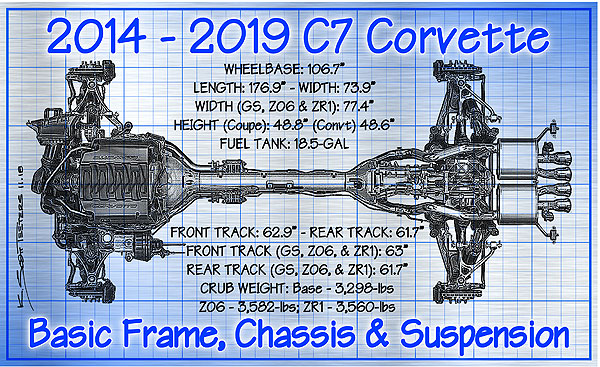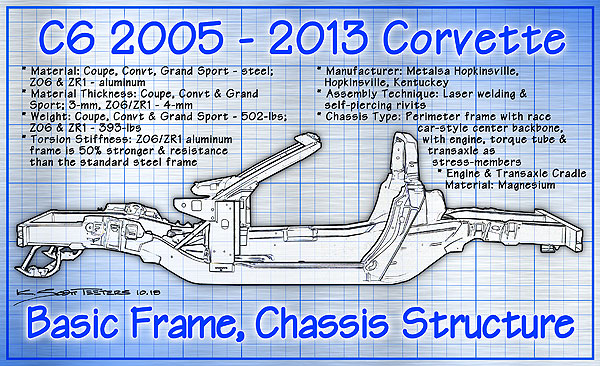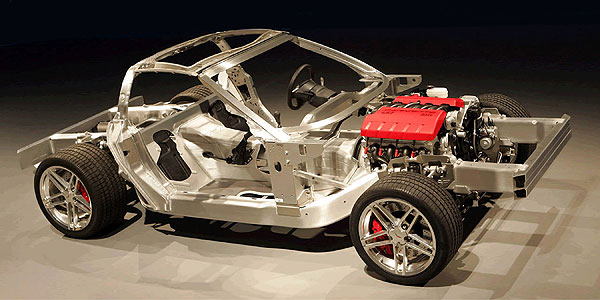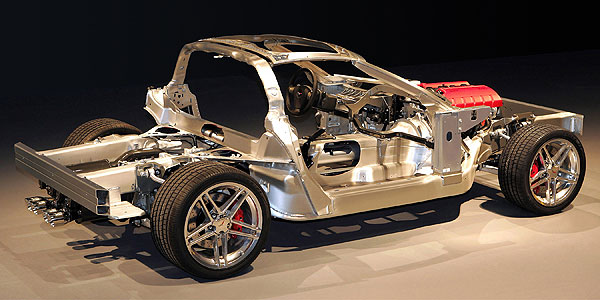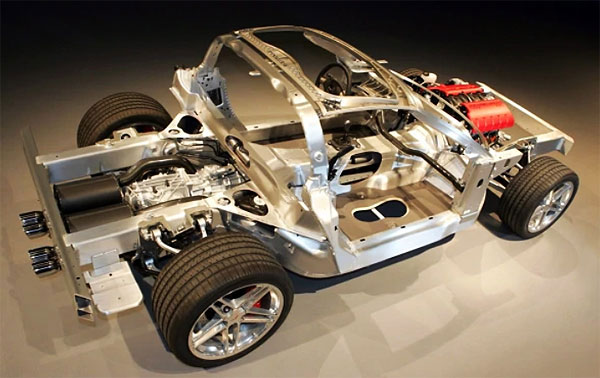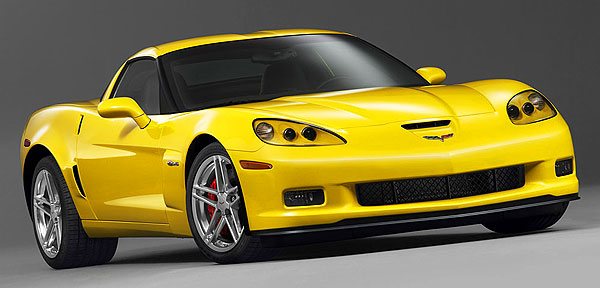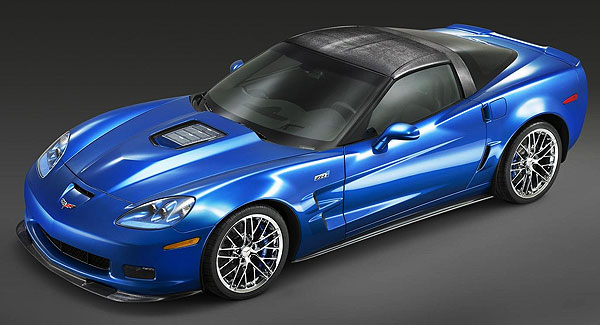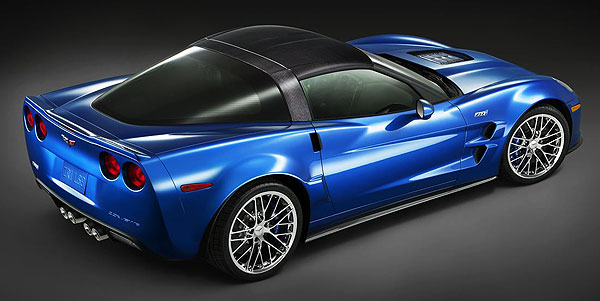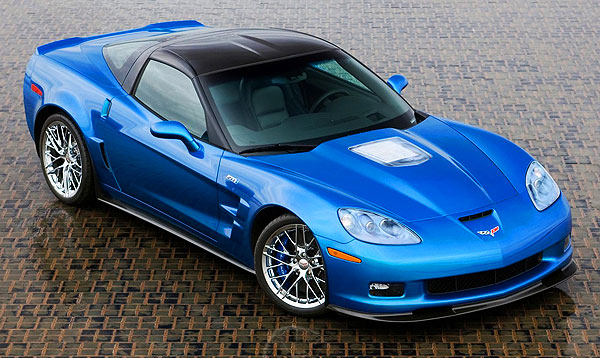Tagdge Juechter’s Genesis Program C7 Chassis
Dateline: 1-20-20, Illustrations & graphics by K. Scott Teeters – The C6 Corvette was a much-improved C5 and was well-received upon release. Fans liked the crisp new look, the new interior (for a while), and the extra grunt. Since the successful arrival of the performance Z06 model in 2001, every new generation Corvette is expected to have a Z06. Within minutes of the C6’s debut, the next question was, “Where’s the Z06?” The following year when the C6 Z06 was unleashed, there was an unanticipated surprise; an aluminum chassis.
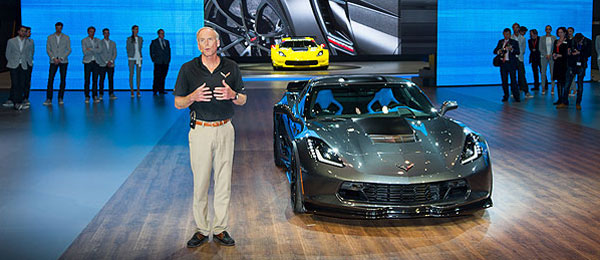
This wasn’t on anyone’s wish list and was a total surprise. It wasn’t even on Zora Arkus-Duntov’s Christmas list! Weighing in at just 3,132-pounds, you have to go back to 1964 to find a lighter Corvette (3,125-pounds). Powered by the mighty 427 LS7 engine with 505 net-horsepower, with C5-R suspension technology, the C6 Z06 was better suited for the track, although many learned how to drive the new beast successfully on the street. The C6 Z06’s aluminum chassis had no trouble handling 638-horsepower in the ZR1 configuration. Bravo Corvette chassis engineers!
When Tadge Juechter’s C7 Corvette debuted, fans were stunned to learn that the base model C7 was built an even better version of the Z06’s aluminum chassis. But wait, there’s more! The same new aluminum chassis would be used for the coupe AND convertible Corvette. This was a major breakthrough and bespeaks of advanced engineering. Here’s how Juechter’s team did it.
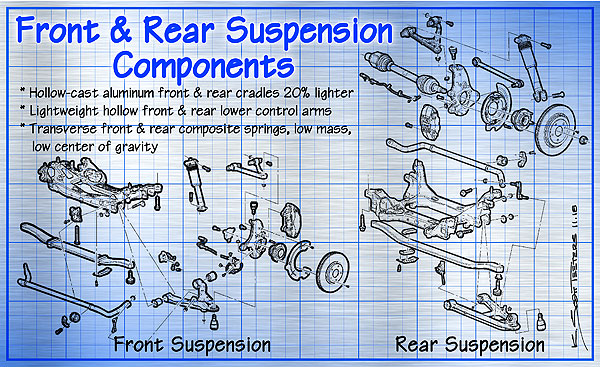
Juechter’s objective was to build a modern performance car that delivered enhanced driving experience, more efficiency that yielded more performance. Every element had to contribute to the overall performance and there would be nothing fake. That explains everything that we see on the C7 Corvette, but what’s unseen is even more amazing.
As we learned from the C5 with its hydroformed side rails, stiffness matters. Juechter is on record stating that while hydroforming was an engineering game-changer, the downside is that parts have a uniform thickness; even in areas where it isn’t needed. Hydroformed parts cannot be tailored for areas that need greater or less strength. Enter the Genesis Software Program.

This is almost computer magic. Engineers first determine the overall block space they want; length, width, and height. Then they determine where they want to place the major components; engine, transmission, suspension assemblies, cabin parts, etc. This creates negative spaces where the structure needs to be to hold everything together. The Genesis Program then synthesizes an optimum structure so that engineers can then take the load design and break it down into parts that can be fabricated and joined together. Afterward, dynamic stress and crash testing is performed and parts modified to meet predetermined objectives.
The C7’s hydroformed aluminum frame rails were optimized for the best the aluminum industry could offer, in terms of tensile strength, lightweight, and materials-joining technology. New aluminum metallurgy and aluminum fastening technologies allow engineers to augment the hydroformed frame with 7000-Series aluminum extrusions designed for specific areas; such as engine/front suspension assembly, transaxle/rear suspension assembly mounting points and frontal collision areas.
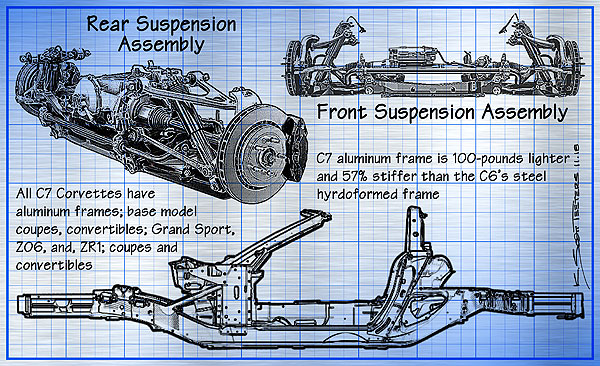
Careful consideration to the placement of major components was also critical. Juechter’s team felt that the C6 was slightly nose-heavy. Components were adjusted so that the C7 is now rear-biased, allowing more load on the rear wheels for better traction at launch; like a racecar. The front wheels were moved forward 1-inch making the wheelbase 106.7-inches. This is the longest wheelbase Corvette ever made. The shortest was the C4, measuring 96.2-inches. Moving the wheels forward also allowed for more space under the hood for the new LT1 engine and various auxiliary systems. This also preserved “crash space” in the front.
Offering an aluminum frame for the coupe and convertible was a big challenge for the team. But because the basic frame structure is so strong, it didn’t need additional roof structure via a fixed roof. The net result is that not only can the Z06 and ZR1 have lift-off rood panels, but both can also be offered as a convertible. This was unimaginable for the C5 Z06, C6 Z06, and the C6 ZR1. According to Ed Moss, the C7 structural engineer group manager, his engineering team tailored sixteen different thicknesses of various grades of aluminum from 11-mm to 2-mm. The completed C7 aluminum frame is 100-pounds lighter than the C6’s steel frame and is 60-percent stiffer. Juechter said that engineers consider the C7’s aluminum chassis to be the most beautiful part of the C7. Perhaps someday Chevrolet will offer a transparent carbon fiber body option.
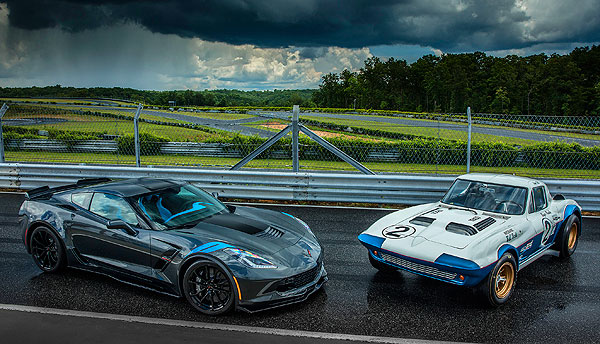
The C7 frame was also designed for aerodynamic efficiency. In the past, engineers tended to only consider how air passed over and under a performance car. The C7 literally breathes. Spaces under the car’s skin and in between the chassis structure were designed for the internal ducting for engine cooling, brakes, transmission, and differential cooling, and venting. Other spaces allowed for electrical and plumbing fixtures for coolant, fuel, and air conditioning ducting.
The C7 design team worked closely with the Corvette Racing Team on airflow management because even racecars are concerned about fuel consumption, as well as top speed dynamics and stability. Two of the most obvious ducting and venting features is the air extractor on the hood, and the NACA ducts on the top of the rear fenders.
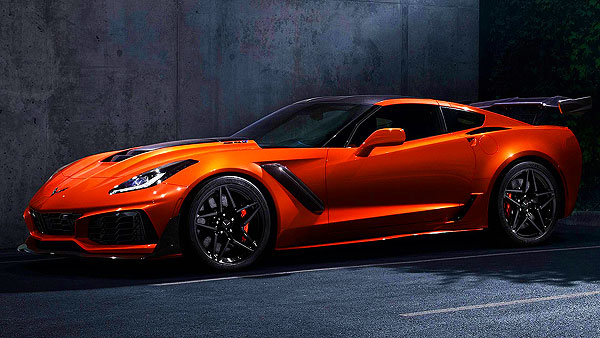
Taking a lesson from the C6.R Corvette racecars, the C7’s radiator is tilted forward. One-third of the air that passes through the radiator is vented out of the hood. The hood louvers are angled so that the exiting air flows tightly over the car creating additional downforce to the nose of the car; thus eliminating the dreaded nose lift.
Heat exchangers (radiators) for the transmission were placed in the back, close to the transaxle with air ducted through the NACA duct feeding into the heat exchangers and then vented out through vents next to the taillights. This is just another example of how every element on the C7 has a defined purpose.
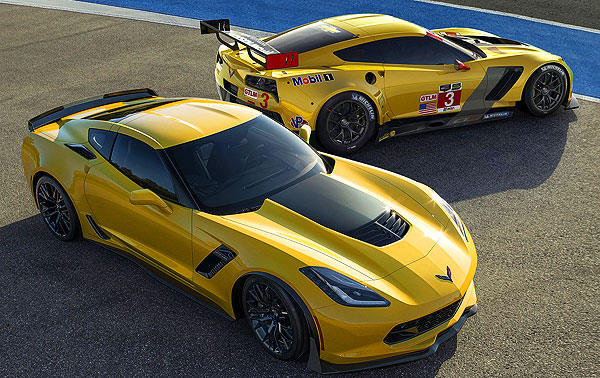
All of the foundational work that went into the C7’s chassis laid down a structure what was easily adaptable to the $2,780 Z51 suspension option that included; performance brakes with slotted rotors; dry-sump oil system; suspension upgrades; special wheels and tires; electronic limited-slip differential with a cooler, performance gearing, and an aero package. The Z51 was for drivers that wanted to use more of the C7 460-horsepower and explore the pleasures of the C7’s superior structure.
The 2015 Z06 with its supercharged 650-horsepower LT4 engine, wide-body, suspension, and tire enhancements work wonderfully with the C7’s basic structure. The same can be said for the 755-horsepower ZR1; the basic structure is up to the task. Arguably, the most interesting use of available C7 components is the Grand Sport. It has the aggressive-looking Z06 body and suspension parts that take using the base model’s 460-horsepower to a whole new level.

I will now go out on a limb. At the C7 ZR1 debut in 2018, Juechter said that his engineers had taken the C7 as far as they could with the ZR1. Are they working on a C9 Corvette to sell alongside the mid-engine C8? If so, will it be built on a carbon fiber chassis? When it comes to Corvettes, things always evolve upward. – Scott

Corvette Chassis History, Pt 1 – C1 Chassis – HERE
Corvette Chassis History, Pt 2 – C2/C3 Chassis – HERE
Corvette Chassis History, Pt 3 – C4 Chassis – HERE
Corvette Chassis History, Pt 4 – C5 Chassis – HERE
Corvette Chassis History, Pt 5 – C6 Chassis – HERE

